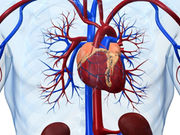Left ventricular mass indexed to body size improves risk prediction for CHD, CVD, heart failure
MONDAY, Aug. 29, 2016 (HealthDay News) — Left ventricular mass indexed to body size (LV mass index [echo-LMVI]) can improve cardiovascular disease (CVD) risk prediction in older adults, according to a study published in the Sept. 1 issue of The American Journal of Cardiology.
Chintan S. Desai, M.D., from the Johns Hopkins Hospital in Baltimore, and colleagues examined whether LV mass and geometry contribute to CVD risk prediction in adults aged ≥65 years. Echo-LVMI and LV geometry (defined as normal, concentric remodeling, and eccentric or concentric LV hypertrophy) were added to separate 10-year risk prediction models, and the net reclassification improvement (NRI) was determined for incident coronary heart disease (CHD), cardiovascular disease (CHD, heart failure, and stroke), and heart failure alone.
The researchers found that, in 2,577 participants, the adjusted hazard ratios for a one-standard deviation higher echo-LVMI were 1.25, 1.24, and 1.51, respectively, for CHD, CVD, and heart failure alone, over 10 years of follow-up. The event NRI was −0.011 and the nonevent NRI was 0.034 with addition of echo-LMVI to the standard model for CHD. The event NRI was 0.013 and the nonevent NRI was 0.043 for addition of echo-LMVI and LV geometry to the standard model for CVD. With addition of echo-LVMI, the nonevent NRI was also significant for heart failure risk prediction (0.10).
“In conclusion, in adults aged ≥65 years, echo-LVMI improved risk prediction for CHD, CVD, and heart failure, driven primarily by improved reclassification of nonevents,” the authors write.
Copyright © 2016 HealthDay. All rights reserved.








